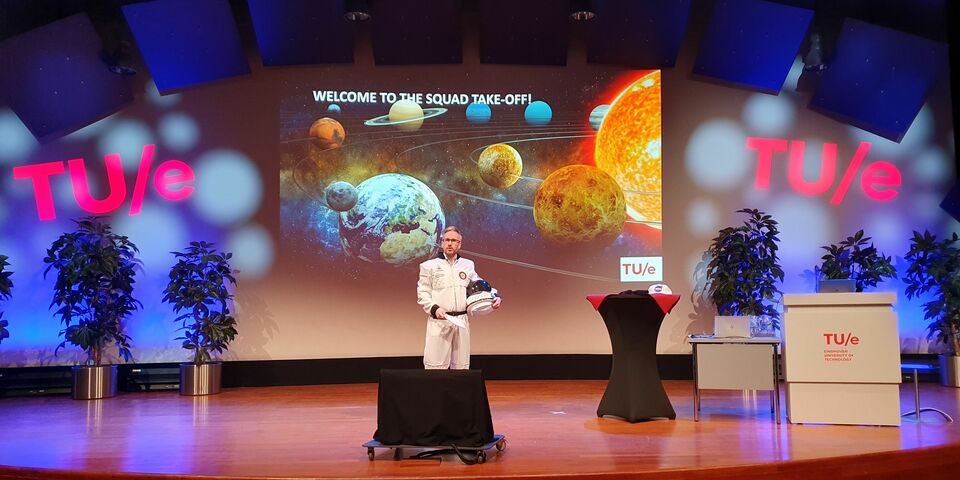SQUAD round four is “ready for take off”
All employees involved in the fourth round of the SQUAD operation were invited to attend the Big Take-off on Monday in the Blauwe Zaal. There, speaker Sidney Brouwer taught them three ways to improve service: “Empathize with your customer, be someone who adds value and start every meeting with a one-minute talk about your service.” Cursor was also there to take note.
Employees from Education and Student Affairs, the Communication Expertise Center, General Affairs and Research Support & Valorization were treated not only to coffee with a macaron at the Take-off of SQUAD, (acronym for Support Quality Drive, Ed.), but also to a humorous and inspiring lecture. Sydney Brouwer, professional speaker on customer orientation, knew how to captivate the audience with content-related stories.
First, the four service directors were given the opportunity to tell host Barry Fitzgerald how far along they were in shaping SQUAD. This ranged from the inventory phase (GA) to complete roadmaps (ESA). Dressed in a space suit, the host invited the directors to share their views on where TU/e is headed. The objective of this morning was already stated by Vice President of the Executive Board Patrick Groothuis: “Ask yourself how we can provide quality services to TU/e at a fair price.”
Keynote speaker Brouwer offers three tips for improving service. He explains that Disneyland employees are taught in their first training session how to answer the frequently asked question: “What time is the three o’clock parade?” Not “At three o'clock,” as the first four people in the audience respond when asked. “There’s more to this, of course. Maybe the person wants to know if they can still catch the start from the location where they ask the question. Or they’re tired and hope to find a good spot along the route for their children. The best answer is: “There’s a reason why you’re asking that”. Then you listen to the customer so you can help them in the best possible way.”
Be +1
Brouwer introduces the second tip with a fun exercise for two people, which everyone enthusiastically engages in. Person A tells a story that starts with “John walked through the woods looking for bears”. Person B then keeps throwing in words that A has to incorporate into the story. Afterwards, we discuss the exercise and understand that you can either work against your partner or encourage them to make the story even more fun or exciting. Brouwer calls the first type a -1 person and the second a +1 person. “Be that +1”, he advises.
The last recommendation involves adopting a new routine. Brouwer copied it from a client who started every meeting with a “safety minute”. “Have there been any announcements, any new policies, is there something I need to know, and where is the emergency exit? Those questions were asked at the start of every meeting, whether it was with two or a hundred people. Why not introduce a Customer Minute in service? With questions like: how did we make a customer happy this week? What did we learn from a customer? What do customers appreciate about us?”
He concludes with a rule he learned as an eight-year-old boy in scouting. “When we went somewhere, we were told to look around us and make sure the place looked better when we left. I translate that to: “Always leave your customer better than you found them.”
During Fitzgerald’s closing words, the mentimeter is put to use. One of the questions asked is which of the tips is your favorite. It’s not the Customer Minute. The majority of the audience wants to try to become a +1.



Discussion